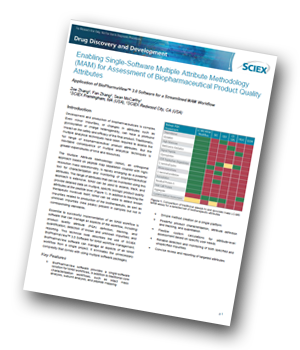This technical note from SCIEX will highlight how to implement a complete and easy-to-use Multiple Attribute Methodology (MAM) workflow for biotherapeutic PQA monitoring using accurate mass LC–MS. It will demonstrate how this new streamlined MAM workflow can be used to track known impurities and identify new impurities using a single software processing system that is as powerful as it is intuitive. You will learn how to reduce your analytical testing burden by incorporating LC–MS into the development process.

 Biotherapeutics require extensive characterization and monitoring throughout the development and manufacturing process. Product quality attributes (PQAs) are defined as attributes that may affect safety and efficacy. It is important that PQAs are closely monitored through final production. Currently, a variety of techniques such as UV, LC, or CE are used to indirectly monitor many of these PQAs; however, the direct measurement of multiple PQAs in a single analytical assay could provide in-depth orthogonal data for analysis. High-resolution accurate mass LC-MS can be used to provide a direct measurement of a large number of PQAs in a single assay using a Multiple Attribute Methodology (MAM) workflow.
Biotherapeutics require extensive characterization and monitoring throughout the development and manufacturing process. Product quality attributes (PQAs) are defined as attributes that may affect safety and efficacy. It is important that PQAs are closely monitored through final production. Currently, a variety of techniques such as UV, LC, or CE are used to indirectly monitor many of these PQAs; however, the direct measurement of multiple PQAs in a single analytical assay could provide in-depth orthogonal data for analysis. High-resolution accurate mass LC-MS can be used to provide a direct measurement of a large number of PQAs in a single assay using a Multiple Attribute Methodology (MAM) workflow.
This technical note describes the use of SCIEX BioPharmaViewTM 3.0 Software for MAM workflow management. BioPharmaView software can manage all aspects of an MAM workflow from a single project. It eliminates the unnecessary complexity that comes with using multiple software packages.
This technical note will show you:
- how to set-up and monitor PQAs using accurate mass LC-MS
- how to automate complex calculations for PQA and impurity levels and define limits for pass/fail flags
- how to track known impurities
- how to automatically flag unspecified impurities detected in a product sample.




